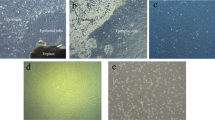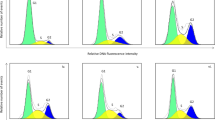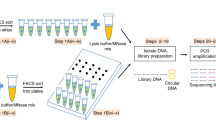Abstract
Chromosome sorting from hybrid cells offers enormous advantages for gene mapping and cloning, but purification of most chromosomes has been largely hindered by their similarity in size to other chromosomes. We have developed a novel cell line and strategy that allows simple, mass purification of mammalian chromosomes, permitting significant target genome enrichment. This strategy takes advantage of the small number of giant chromosomes (1,2,X) of the female Indian muntjac, a barking deer, avoiding the problem of size similarity. We introduced human chromosomes into a cell line derived from a muntjac and purified them to homogeneity using a relatively simple technique.This strategy should facilitate the isolation of chromosomes from species other than human for which hybrid cells are not available currently.
This is a preview of subscription content, access via your institution
Access options
Subscribe to this journal
Receive 12 print issues and online access
$209.00 per year
only $17.42 per issue
Buy this article
- Purchase on Springer Link
- Instant access to full article PDF
Prices may be subject to local taxes which are calculated during checkout
Similar content being viewed by others
References
Stubblefield, E. & Oro, J. The isolation of specific chicken macrochromosomes by zonal centrifugation and flow sorting. Cytometry 2, 273–281 (1991).
Mendelsohn, J., Moore, D.E. & Salzman, N.P. Separation of Isolated Chinese hamster metaphase chromosomes into three size-groups. J. molec. Biol. 32, 101–112 (1968).
Collard, J.G. et al. Separation of large quantities of Chinese hamster chromosomes by velocity sedimentation at unit gravity followed by flow sorting (FACSII). Exp. Cell Res. 130, 217–227 (1980).
Langlois, R.G., Yu, L.-C., Gray, J.W. & Carrano, A.V. Quantitative karyotyping of human chromosomes by dual beam flow cytometry. Proc. natn. Acad. Sci. U.S.A. 79, 7876–7880 (1982).
Bartholdi, M.F., Parson, J.D., Albright, K.A. & Cram, L.S. System for flow sorting chromosomes on the basis of pulse shape. Cytometry 11, 165–172 (1990).
Mullikin, J., Norgren, R., Lucas, J. & Gray, J. Fringe-scan flow cytometry. Cytometry 9, 111–120 (1988).
Lucas, J.N. & Gray, J.W. Centromeric index versus DNA content flow Karyotypes of human chromosomes measured by means of slit-scan flow cytometry. Cytometry 8, 273–279 (1987).
van den Engh, G., Hanson, D. & Trask, B. A computer program for analyzing bivariate flow karyotypes. Cytometry 11, 173–183 (1990).
Deaven, L.L. et al. Construction of human chromosome-specific DNA libraries from flow-sorted chromosomes. Cold Spring Harbor Symp. Quant. Biol. Ll, 159–167 (1986).
Fuscoe, J.C., Clark, L.M. & Van Dilla, M.A. Construction of fifteen human chromosome-specific DNA libraries from flow-purified chromosomes. Cytogenet. cell Genet. 43, 79–86 (1986).
Van Dilla, M.A. & Deaven, L.L. Construction of gene libraries for each human chromosome. Cytometry 11, 208–218 (1990).
Wurster, D.H. & Benirschke, K. Indian Muntjac, Muntiacus muntjak: A deer with a low diploid chromosome number. Science 168, 1364–1366 (1970).
Yuasa, Y., Hirai, R., Shimojo, H. & Yamamoto, T. Transformation of Indian muntjac cells by murine and avian sarcoma viruses. Jpn. J. Cancer Res. 69, 441–445 (1978).
Hatanaka, M. & Klein, R. Tumorigenicity of Indian muntjac diploid cells by the proviral Integration of sarcoma gene of a mouse retrovlrus. J. Exp. Med. 150, 1195–1201 (1979).
Yamaguchi, N. & Huh, N. Establishment and characterization of Indian muntjak cell lines transformed with Simian Virus 40. J. gen. Virol. 42, 289–296 (1979).
American Type Culture Collection, Catalogue of Cell Lines and Hybridomas 7th edn p. 89 (American Type Culture Collection, Rockville, MD, 1992).
Mulligan, R.C. & Berg, P. Selection for animal cells that express the Escherichiacoli gene coding for xanthine-guanine phosphoribosyltransferase. Proc. natn. Acad. Sci. U.S.A. 78, 2072–2076 (1981).
Koi, M. et al. Tumor cell growth arrest caused by subchromosomal transferable DNA fragments from human chromosome 11. Science 260, 361–364 (1993).
Koi, M., Shimizu, M., Morita, H., Yamada, H. & Oshimura, M. Construction of a mouse A9 Clones containing a single human chromosome tagged with neomycin-resistance gene via microcell fusion. Jpn. J. cancer Res. 80, 413–418 (1989).
Cram, L.S., Campbell, M., Fawcett, J.J. & Deaven, L.L. Polyamine buffer for bivariate human flow cytogenetic analysis and sorting. Meth. cell. Biol. 33, 377–381 (1990).
Trask, B. in Flow Cytogenetics (ed. Gray, J.W.) 43–46 (Academic, New York, 1989).
Ruddle, F.H. & Creagan, R.P. Parasexual approaches to the genetics of man. Ann. Rev. Genet. 9, 407–486 (1981).
Graham, F.L. & van der Eb, A.J. A new technique for the assay of infectivity of human adenovirus 5 DNA. Virology 52, 456–467 (1973).
Wigler, M., Pellicer, A., Silverstein, S. & Axel, R. Biochemical transfer of single-copy eucaryotlc genes using total cellular DNA as donor. Cell 14, 725–731 (1978).
Goyette, M.C. et al. Progression of colorectal cancer is associated with multiple tumor suppressor gene defects but inhibition of tumorigenicity is accomplished by correction of any single defect via chromosome transfer. Molec. cell. Biol. 12, 1387–1395 (1992).
Fournier, R.E.K. & Ruddle, F.H. Microcell-mediated transfer of murine chromosomes into mouse, Chinese hamster, and human somatic cells. Proc. natn. Acad. Sci. U.S.A. 74 (1), 319–323 (1977).
Saxon, P.J., Srivatsan, E.S., Leipzig, G.V., Sameshima, J.H. & Stanbridge, E.J. Selective transfer of individual human chromosomes to recipient cells. Molec. cell. Biol. 5, 140–146 (1985).
Deininger, P.L., Jolly, D.J., Rubin, C.M., Friedmann, T. & Schmid, C.W. Base sequence studies of 300 nucleotide renatured repeated human DNA clones. J. molec. Biol. 151, 17–33 (1981).
Feinberg, A.P. & Vogelstein, B. A technique for radiolabeling DNA restriction endonuclease fragments to high specific activity. Anal. Biochem. 132, 6–13 (1983).
Chaconas, G. & Van de Sande, J.H. 5í-32P labeling of RNA and DNA restriction fragments. Meth. Enzymol. 65, 75–85 (1980).
Bogenberger, J.M., Neumaier, P.S. & Fitler, F. The Muntjak satellite IA sequence is composed of 31-base-pair Internal repeats that are highly homologous to the 31-base-pair subrepeats of the bovine satellite 1.715. Eur. J. Biochem. 148, 55–59 (1985).
Author information
Authors and Affiliations
Rights and permissions
About this article
Cite this article
Lee, JY., Koi, M., Stanbridge, E. et al. Simple purification of human chromosomes to homogeneity using muntjac hybrid cells. Nat Genet 7, 29–33 (1994). https://doi.org/10.1038/ng0594-29
Received:
Accepted:
Issue Date:
DOI: https://doi.org/10.1038/ng0594-29
This article is cited by
-
Creating a functional single-chromosome yeast
Nature (2018)
-
Chromosomes in the flow to simplify genome analysis
Functional & Integrative Genomics (2012)
-
Increased missegregation and chromosome loss with decreasing chromosome size in vertebrate cells
Chromosoma (2006)
-
Dominant genetic instability and sensitivity to DNA damaging agents in a mammalian cell line
Somatic Cell and Molecular Genetics (1996)



